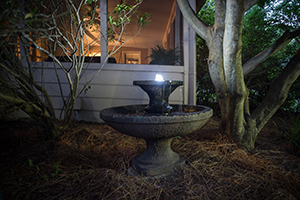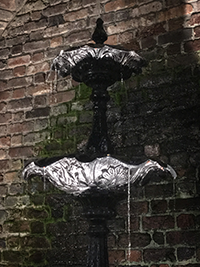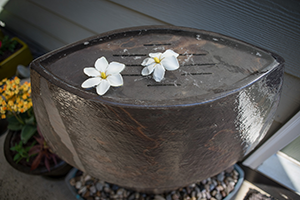By Doug Scott, Landscape Designer
Redeem Your Ground, Atlanta, GA

Aside from the serene and restful spaces that running or bubbling water help create, water features add interest and beauty to landscapes not only with their form, but potentially through the unique plants that grow in and around them, and the wildlife that they attract. When used strategically within a landscape design, they can also serve to anchor an inviting gathering space to create a picture-perfect focal point to be seen and enjoyed from both inside or outside your home.
Ultimately, water features help create the perfect spot to start your day off right, or to unwind by at the end of a long day . . . and really, anytime in between. Some might say they provide an element of liquid bliss.
There are a wide variety of water features to choose from that will allow you to achieve your specific goals, so here are a few general types worth considering. Hopefully, these recommendations will help you choose the one that will provide enjoyment for you and your family for years to come.
Fountains
Fountains are perhaps the most common type of water feature that can be added to your landscape. That’s likely due to a number of reasons:
- They come in a variety of shapes, colors and styles. From classic tiered fountains, colorful urns and funky objects, to extravagant installations or a simple stone with a bubbler atop it, there’s a fountain option that will meet any design aesthetic.
- There are options that will fit any budget—big or small.
- There are very large fountains that you could consider (if your budget allows), as well as small options that will work within the smallest of spaces.
- Compared to the other types of available water features, many fountain options are relatively easy to source from a number of retailers, then install yourself and maintain.
For these reasons, most of the water features I’ve installed for clients have been of the fountain variety. They effectively achieve the “bubbling-water sound” objective that most people are looking for, while fitting both their space and budget constraints, as well.
Water Gardens & Fish Ponds
If you’re wanting to bring life to your outdoor spaces in the truest sense, water gardens and fish ponds do just that.
Water gardens are exactly what their name implies: a garden of plants that live in and around water. They provide you with the opportunity to include unique plants in your landscape, bringing with them vibrant colors and interesting structures. Common water garden plants are horsetail, water lettuce, water lilies, blue iris and sweet flag. Note that water gardens are best when incorporated in a more natural, lush setting.
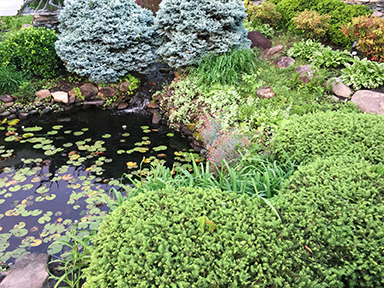
Like water gardens, fish ponds are most often incorporated into more naturalized landscapes. Likewise, the plants used in fish ponds are the same as in water gardens. The added bonus with fish ponds, however, is that you’ll be able to enjoy the fish you’re providing a home for—koi and goldfish being the most common.
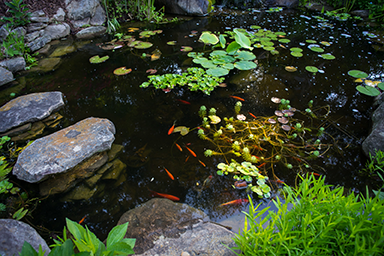
The primary difference between water gardens and fish ponds is that fish ponds must be able to sustain the fish that will reside in them. This not only adds to the cost and complexity of starting a fish pond, but the ongoing maintenance that’s involved, as well. For instance:
- Fish need oxygen, so you must have a pump that circulates and aerates the water.
- You must have appropriate types of vegetation, as well. That’s because plants serve three vital functions in your fish pond:
- They produce oxygen.
- They provide a great natural source of food.
- They not only help beautify the space, but also provide cover from predators, as well as shade from the beaming sun. (It’s recommended that about half of the pond have some sort of shade.)
Given that both water gardens and fish ponds can serve as a ready source of water, food and habitat, they provide the added bonus of attracting all sorts of wildlife. But, this can be both a good and bad thing.
Let’s start with the bad. If you’re raising fish, you’ll have to watch out for predators that come from both land and air. Cats, possums, raccoons, foxes and birds (like herons, seagulls, and kingfishers) are known to feast on fish.
Although there’s no fail-safe way to prevent the unthinkable, a three-pronged approach to safeguard against predators is recommended:
- Provide your fish cover (somewhere to hide), as mentioned above.
- Like in a vegetable garden, place an owl decoy nearby to deter unwanted attacks.
- Although not very attractive, you could install a net over your fish pond.
Now, with the bad out of the way, there’s also the good wildlife that’s attracted to a water garden or fish pond. Amphibians like frogs and toads (though, they can pose a problem with fish ponds, so watch for that), birds (the colorful, cute kind, not the predatory kind), and beneficial insects like dragonflies and water spiders are sure to take up residence in this type of water feature.
For obvious reasons, adding a water feature to your yard is a much more involved endeavor than a fountain that you simply pull out of a box and plug in. However, if you’re up for the challenge, the life they will bring to you and your family outside is endless.
Streams & Waterfalls
Lastly, streams and waterfalls are another great water feature option to consider if the goal is to add natural beauty and movement to your landscape. Although they can be installed individually, waterfalls and streams are often used together, and can even be incorporated with a water garden or fish pond.

Like a garden path, streams help create a more natural, meandering setting . This provides you with the opportunity to connect the visual dots from one space to another within your yard, accentuating its curves with boulders or plant material. And, not only do streams bring a beautiful sense of wonder to a space, they can serve the functional purpose of helping you manage drainage, too.
Waterfalls are another great way to add even more sound and drama to your yard. Like streams, they work well when there is a natural grade change, allowing you to take advantage of the drop from one space to another. However, this drop can be created quite effectively with boulders, as well.
Like fountains, waterfalls and streams require a bit of engineering to recirculate and maintain the water appropriately. However, unlike fountains, I’d recommend that you consider hiring a professional for installation, as there are a number of things that could go wrong during the process.
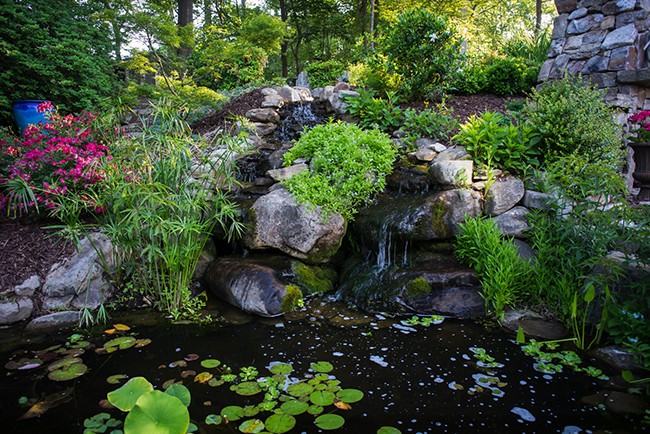
Whether you’re looking to add the “oh-so-soothing” sounds that only running water can provide, or simply for a unique way to enhance the natural beauty and interest of your outdoor spaces, a water feature could be the answer. Because, let’s face it—everyone could use a little bit of liquid bliss!


